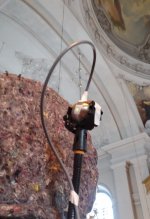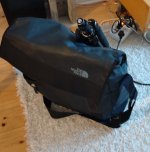Macel - what DC levels on each pin on the OP amp should I anticipate?
For the now replaced mic I see basically OK 15 volts and on the rest about 1,9V - would that be OK?
I suspect not...
On the scope I see some varying HF with tens of mV's...
The OP amp itself got actually a little bit of varm efter a while - an indication I suppose that there is some oscillating going on...
Where to put a few of 0,1 uF's to make the whole thing stable?
Thanks for any help / suggestions!!
//
For the now replaced mic I see basically OK 15 volts and on the rest about 1,9V - would that be OK?
I suspect not...
On the scope I see some varying HF with tens of mV's...
The OP amp itself got actually a little bit of varm efter a while - an indication I suppose that there is some oscillating going on...
Where to put a few of 0,1 uF's to make the whole thing stable?
Thanks for any help / suggestions!!
//
Yes
Yes
Yes
Yes for 1/2 but haven't checked 3 - did check 6/7 and anticipated same as for 1/2 but it didn't seem to be knock sensitive. I'll check 3!
Yes stable 6/7 (5?) but some hf oscs...
Maybe there is hope
All is a bit exposed so this might be a problems also...?

(Powered off)
//
Yes
Yes
Yes for 1/2 but haven't checked 3 - did check 6/7 and anticipated same as for 1/2 but it didn't seem to be knock sensitive. I'll check 3!
Yes stable 6/7 (5?) but some hf oscs...
Maybe there is hope
All is a bit exposed so this might be a problems also...?
(Powered off)
//
Last edited:
OK!
While I'm contemplating the situation with the TI EVM, I acquired on of these.

It was not solely for this project but I had hoped it could be a gap filler while I'm dealing with the EVM so that I could start doing some trials with the mics. But now that I understand that it is single end, maybe it will not be a reasonably match...
//
While I'm contemplating the situation with the TI EVM, I acquired on of these.
It was not solely for this project but I had hoped it could be a gap filler while I'm dealing with the EVM so that I could start doing some trials with the mics. But now that I understand that it is single end, maybe it will not be a reasonably match...
//
Assuming its XLR inputs are line inputs only, so with no risk of activating a phantom supply, it should work. A single-ended signal is mathematically the same as a differential signal with a common mode signal of half the amplitude.
The noise floor is probably poor and if the Cosmos has input transformers (which I don't expect it has), their cores may get magnetized.
The noise floor is probably poor and if the Cosmos has input transformers (which I don't expect it has), their cores may get magnetized.
Checking the EVM situation...
My purchase invoice says 156€ inc tax&post from TI. TI dont recognise my user account any more - have there been some changes there?
Mouser and Farnell seem to be willing to send one tomorrow if I part with around 330€ inc tax/post
Changing times...
I'll of course also consider repair...
The PCM AD is available at 26€ + tax/post
The OP amps are not available at Mouser but cost each 5 and there is 4 of them.
->100€ if all these 5 items are broken...
So need to isolate what is the matter with the unit.
Also, changing out the TI AD will be a real challenge for me and with an uncertain outcome to say the leat 🙃
Will dig into all of this...
//
My purchase invoice says 156€ inc tax&post from TI. TI dont recognise my user account any more - have there been some changes there?
Mouser and Farnell seem to be willing to send one tomorrow if I part with around 330€ inc tax/post
Changing times...
I'll of course also consider repair...
The PCM AD is available at 26€ + tax/post
The OP amps are not available at Mouser but cost each 5 and there is 4 of them.
->100€ if all these 5 items are broken...
So need to isolate what is the matter with the unit.
Also, changing out the TI AD will be a real challenge for me and with an uncertain outcome to say the leat 🙃
Will dig into all of this...
//
The noise floor is probably poor
Wrong! TNT informed me that the noise floor is of the order of -127.8 dB(A) with respect to full scale and that the full scale level can be set to different values.
Attached is first recording (24/96) excerpt with the microphones using Cosmos ADC at highest sensitivity. I mod'd the Line-audio mic holders to fit the "kugel" - this needs an other solution....
Gain added digitally in post was 30dB.
Stats for the whole recorded file after gain added:
Minimum sample value -0.4167 -0.6284
Maximum sample value 0.5069 0.7017
Peak amplitude -5.9 dB -3.1 dB
DC offset 0.0013 0.0026
Minimum RMS power -51.9 dB -49.8 dB
Average RMS power -31.0 dB -29.1 dB
Maximum RMS power -20.1 dB -17.6 dB
Clipped samples 0 0
Mic halfs where only taped together (with a slight gap for the cable) so not in their final intended fashion. One can see the green LED shining thru the taped hole where the cable shall go in eventually...
Picture shows all packed up for field duty.


//
Gain added digitally in post was 30dB.
Stats for the whole recorded file after gain added:
Minimum sample value -0.4167 -0.6284
Maximum sample value 0.5069 0.7017
Peak amplitude -5.9 dB -3.1 dB
DC offset 0.0013 0.0026
Minimum RMS power -51.9 dB -49.8 dB
Average RMS power -31.0 dB -29.1 dB
Maximum RMS power -20.1 dB -17.6 dB
Clipped samples 0 0
Mic halfs where only taped together (with a slight gap for the cable) so not in their final intended fashion. One can see the green LED shining thru the taped hole where the cable shall go in eventually...
Picture shows all packed up for field duty.


//
Attachments
Is it possible and how can one practically realise a 6th order analog LP filter between the mic and the AD?
The digital filters in a AD, don't they suffer inherently by aliasing/folding so that the only true way of getting rid of back-folding is a really effective analog filtering before the sample_&_hold AD process?
(S&H is basically analog in its nature (?), but once a level has be assigned a numeral (digitised), ie. now in the digital domain, any alias is also imprinted at this very moment - but before any digital filtering can be done, it is in need of have been digitised - so how can a digital filter prevent alias?)
//
The digital filters in a AD, don't they suffer inherently by aliasing/folding so that the only true way of getting rid of back-folding is a really effective analog filtering before the sample_&_hold AD process?
(S&H is basically analog in its nature (?), but once a level has be assigned a numeral (digitised), ie. now in the digital domain, any alias is also imprinted at this very moment - but before any digital filtering can be done, it is in need of have been digitised - so how can a digital filter prevent alias?)
//
Why sixth order?
The digital filter only prevents (or nearly prevents, as its stop band rejection is finite) the extra aliases that you get due to decimation.
That is, a sigma-delta audio ADC samples the audio signal at a rate in the megahertz range. Any input frequency components that are within 20 kHz from an integer multiple of the sigma-delta sample rate will alias to frequencies below 20 kHz, and there is nothing any digital filter can do about that.
Afterwards, the sample rate is reduced (decimated) to a normal audio sample rate, like 96 kHz or 44.1 kHz or whatever. The digital decimation filter chain ensures you get (practically) no additional aliases from this process.
The digital filter only prevents (or nearly prevents, as its stop band rejection is finite) the extra aliases that you get due to decimation.
That is, a sigma-delta audio ADC samples the audio signal at a rate in the megahertz range. Any input frequency components that are within 20 kHz from an integer multiple of the sigma-delta sample rate will alias to frequencies below 20 kHz, and there is nothing any digital filter can do about that.
Afterwards, the sample rate is reduced (decimated) to a normal audio sample rate, like 96 kHz or 44.1 kHz or whatever. The digital decimation filter chain ensures you get (practically) no additional aliases from this process.
It seems properly steep to get rid of anything dangerous at 96 dB down at 20k->3oct = 160kHz -> Fs = 384 . But OK, I see, so no need to worry about aliasing - is that what you are saying.
With the scheme you describe, is the "only" thing the filters in a AD needs to do is to remove the mirrors which is basically "hf noise"?
This from the Cosmos AD:

Which one would you use Marcel?

//
With the scheme you describe, is the "only" thing the filters in a AD needs to do is to remove the mirrors which is basically "hf noise"?
This from the Cosmos AD:
Which one would you use Marcel?
//
Last edited:
Linear phase apodizing, as it is the only one that has a stop band starting at fs/2 and not higher.
According to the datasheet, the ES9822 modulator clock frequency is 22.5792 MHz to 24.576 MHz. If that is also the modulator sample rate, the analogue part only has to suppress signals above 22 MHz to avoid aliasing. The microphone itself probably already has quite some attenuation there, and the only acoustic signals are presumably very high harmonics of bat echolocation signals.
According to the datasheet, the ES9822 modulator clock frequency is 22.5792 MHz to 24.576 MHz. If that is also the modulator sample rate, the analogue part only has to suppress signals above 22 MHz to avoid aliasing. The microphone itself probably already has quite some attenuation there, and the only acoustic signals are presumably very high harmonics of bat echolocation signals.
Had a little misconfiguration of the Cosmos AD last time - now corrected. I have also added som damping material inside the mics. I think also perhaps better suspension of the mics in the stand.

Please find the attachment for a short excerpt from earlier today recording - the final of a Christmas inspired organ concert.
Minimum sample value -0.9408 -0.8176
Maximum sample value 0.8145 0.8267
Peak amplitude -0.5 dB -1.7 dB
DC offset -0.0001 0.0049
Minimum RMS power -49.7 dB -51.0 dB
Average RMS power -17.3 dB -18.0 dB
Maximum RMS power -12.4 dB -13.5 dB
Clipped samples 0 0
I'm quite pleased - what do You think?
//
Please find the attachment for a short excerpt from earlier today recording - the final of a Christmas inspired organ concert.
Minimum sample value -0.9408 -0.8176
Maximum sample value 0.8145 0.8267
Peak amplitude -0.5 dB -1.7 dB
DC offset -0.0001 0.0049
Minimum RMS power -49.7 dB -51.0 dB
Average RMS power -17.3 dB -18.0 dB
Maximum RMS power -12.4 dB -13.5 dB
Clipped samples 0 0
I'm quite pleased - what do You think?
//
Attachments
Last edited:
- Home
- Source & Line
- Digital Line Level
- Fixed gain field recorder?